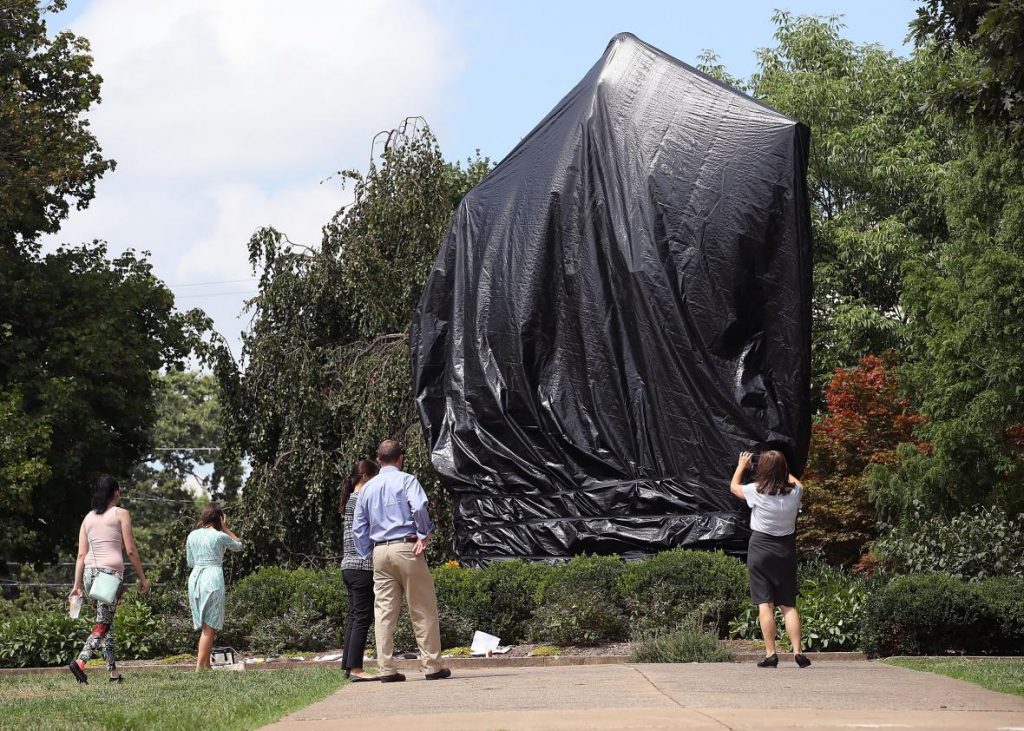Local leaders seeking guidance for Confederate monuments, while state lawmakers, governor hopefuls oppose removal
Zach Vance and Nathan Baker • Updated Aug. 18, 2017 at 8:53 AM
zvance@johnsoncitypress.com / nbaker@johnsoncitypress.com
Local and state leaders are wrestling with their responses to the deadly events in Charlottesville, Virginia, over the weekend, where white supremacists violently clashed with counter protesters over the city’s plans to remove a statue of Confederate commander Robert E. Lee.
Two days after the terrorist act that left one woman dead, communities from Florida to Maryland detailed their plans to remove or destroy existing monuments to the former Confederacy and its soldiers, some already underway when the violence erupted in Virginia.
In Durham, North Carolina, an angry group ignored the state’s 2015 law barring the removal of Confederate monuments when protesters climbed a statue dedicated to “the Boys Who Wore The Gray” in front of the town’s old courthouse, tied a rope to it and pulled it down.
Aside from grave markers, our region only has a handful of Confederate monuments on public property, likely because many of the counties in Northeast Tennessee resisted the state’s secession from the Union until Confederate soldiers were sent to suppress the open rebellion, and even after, residents remained deeply divided on the causes that precipitated the Civil War.
In Bristol, Virginia’s Cumberland Square Park, a Confederate soldier stands in stone atop a pillar dedicated “In memory of the brave men and noble women of Tennessee and Virginia from 1861 to 1865.”
The monument was donated to the United Daughters of the Confederacy in 1920 by Confederate Col. James Madison Barker. It originally stood in front of the city’s courthouse, but was moved to the train depot when the courthouse was torn down in 1970. It was moved and cleaned by the Confederate women’s group a few years ago.
Bristol Interim City Manager Randy Eads said no one has complained or threatened the monument in Cumberland Square Park, but said he’ll ask City Councilors early next week to discuss the monument and whether any action should be taken.
“I just want to see what their thoughts are, then they can meet with members of their communities,” Eads said. “It’s a community issue, and we need to look at it from a community standpoint and see what we should do.”
Eads said the issue likely won’t be on the City Commission’s next agenda, but could be up for consideration on Sept. 12.
“Obviously I’m worried by the events that have taken place,” he said. “The last thing I want in the City of Bristol is a situation where we’re making national news for something like this. I hope if there are any citizens with concerns, they will come to talk with us prior to trying to destroy property.”
In Greeneville, where pro-Union leaders met in 1861 in an attempt to remove Northeast Tennessee from the rest of the state’s decision to secede, a monument to Union soldiers and a statue of a Confederate general stand outside the Greene County Courthouse.
The Union monument is dedicated “To the memory of the Union soldiers who enlisted in the Union army from Greene County — War 1861-1865.” The other side of the obelisk says “In the hour of their country’s peril they were loyal and true.”
Nearby, a large granite monument dedicated to Confederate general John Hunt Morgan, who was killed in Greeneville, boasts “His heroism is the heritage of the South.” The historic General Morgan Inn is also named for him.
“I’ve always heard there was (a monument) for each side, but I don’t think anyone who lives here could find them if you asked them where they were,” Greene County Mayor David Crum said.
Crum said his office hasn’t taken any calls about Confederate monuments, but he added that a proposal to the County Commission to fly the Confederate flag at the courthouse only received one vote from a body of 24 commissioners.
Likewise, Sullivan County Mayor Richard Venable said he hadn’t been approached by any constituents concerned about the granite memorial at Blountville’s courthouse dedicated “To the memory of the Confederate soldiers.”
“I wouldn’t anticipate anything coming out of it, but you never know,” Venable said. “I don’t think it’s aggressive, and I don’t think it’s in your face. I think heritage means a lot to folks around here.”
In Erwin, a monument dedicated to Confederate soldiers, Confederate women and World War I veterans is in a narrow triangle of grass between Unaka Way Street and Ohio Avenue. In Kingsport, a stone marker sits beside a walking path “dedicated to those brave Confederates and those from East Tennessee who served in defense of their Southern homeland.”
Officials in Erwin and Kingsport did not return calls seeking comments about those monuments.
If local officials are looking for guidance from state leaders about the monuments, they may get mixed signals.
After a protest at the state Capitol in front of a bust of Nathan Bedford Forrest, a Confederate general and an early member and leader of the Ku Klux Klan, Tennessee Gov. Bill Haslam said the bust should be removed.
But it’s not that easy. The Tennessee Heritage Protection Act passed last year by the General Assembly requires a two-thirds vote of the state Historical Commission before the removal of a symbol or artifact related to the Civil War and other conflicts.
After President Donald Trump cast blame on both white supremacists and the “alt left” for the death and destruction in Charlottesville, Rep. Micah Van Huss, R-Jonesborough, took to Facebook to post his support.
Van Huss called Trump’s comments a “truth session” and solidified his support for the public display of Confederate monuments.
“I rarely post political statements on my personal Facebook page. After listening to our President last night, I feel the need to let my constituents know where I stand. Black Lives Matter, the KKK, and Neo-Nazis are racist hate groups and I condemn them,” Van Huss wrote. “Some of those groups have taken a banner that is dear to my heart and made it one of their symbols. For me, Robert E. Lee’s battle flag is a symbol of freedom. Stonewall Jackson was my father’s hero.”
In a phone call to the Johnson City Press on Thursday, Van Huss said too many politicians lack the “guts” to stand up and say what’s right.
“I would say I don’t live in a politically correct fantasy world that most people tend to live in today,” Van Huss said.
“I live in the real world and I’m going to represent my constituents from that viewpoint. I’m not really worried about my status or whether I get re-elected or not. I’m going to stand for what’s right, and live the rest of my life happy with whatever God tells me to do.”
In defense of keeping Confederate monuments standing, Van Huss said the secession of the South is a part of history that can be learned from but can’t be erased. He also mentioned that slavery existed in the United States for 85 years before the Confederacy was established.
“Folks want to go down this road to try to erase history, to try to erase any semblance of the evil that our country and the Confederacy, both did with slavery,” said Van Huss, who cited a PBS survey in which 62 percent of Americans supported keeping Confederate monuments.
“People want to try to erase that and where does it end is my question. If you go down this road, you eventually have to get rid of the Democrat Party because the Democrat Party is what did this.”
Kate Craig, chairwoman of the Washington County Democratic Party, said Van Huss passed up a valuable opportunity to begin healing a divided country.
“At a time when this nation, and his constituents are crying out for sanity and civility from our leaders, Representative Van Huss intentionally allowed the opportunity to pass him by. In his personal example of General Robert E. Lee’s battle flag as a symbol of freedom, which in reality is a symbol of oppression, murder, sexual violence, and stolen identities for generations of enslaved African Americans, he places the economic gains of rich, white Americans over every person of color in this country,” Craig wrote.
Pat Buck, vice president of the Carter County Democratic Women’s Club, called Van Huss’ comments “beyond outrageous.”
Despite his criticism, gubernatorial candidates Bill Lee, Randy Boyd, Beth Harwell and Kay White all supported preserving Confederate monuments.
“There is a delicate balance that needs to be drawn. We should not wash away history just because some deem it offensive. We should always try to learn from those who came before us,” Lee said in a statement.
Harwell said, “I do not think we should be removing things that have historical significance like the bust of Nathan Bedford Forrest. I recognize that there are very passionate people on both sides of this issue and the overwhelming majority of them do not come from a place of hate. There is process of removing or relocating historical statues and monuments, and it is a fair one that allows for ample public input.”
Boyd plainly stated he opposed the wholesale removal of historical displays and monuments. “If we cannot learn from the past, then we are surely destined to repeat it,” he said.
In her support for Confederate monuments, White, from Johnson City, said destroying them is destroying public property, which taxpayers funded.
“This is wrong and tearing down a statue will not change history,” White wrote.

